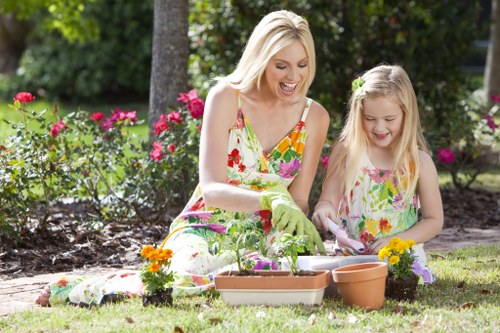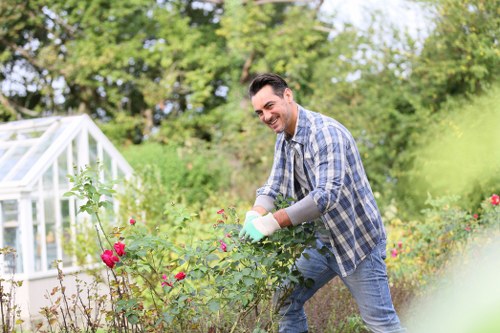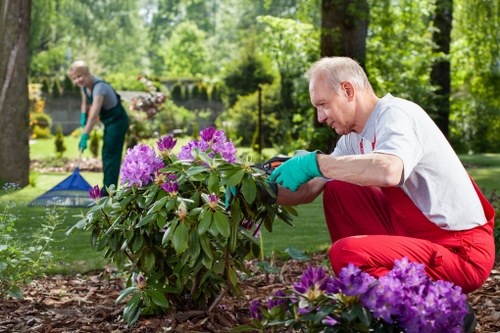Comprehensive Guide to Garden Maintenance in Hampstead
Introduction to Garden Maintenance

Maintaining a garden in Hampstead requires a blend of passion, knowledge, and dedication. The unique climate and soil conditions in Hampstead mean that gardeners must adopt specific strategies to ensure their gardens thrive throughout the year.
Whether you're a seasoned gardener or a novice, understanding the fundamentals of garden maintenance can transform your outdoor space into a lush and vibrant oasis. This guide delves into the essential aspects of garden care tailored specifically for Hampstead's environment.
From soil preparation and plant selection to pest control and seasonal tasks, we'll explore the best practices to keep your garden healthy and beautiful. Let's embark on this gardening journey together!
Understanding Hampstead’s Climate

Climate Overview
Hampstead enjoys a temperate climate with mild winters and warm summers, making it an ideal location for a diverse range of plants. However, the area's microclimates can vary, influencing the types of vegetation that thrive.
Seasonal Considerations
Each season presents unique challenges and opportunities for garden maintenance. Proper planning and timely interventions can help mitigate adverse effects and enhance plant growth.
Impact on Plant Selection
Choosing plants that are well-suited to Hampstead's climate ensures better growth and reduces the need for extensive maintenance. Opt for native species and those adapted to the local conditions for optimal results.
Soil Preparation and Health

Testing Soil Quality
Before planting, it's crucial to assess the soil quality. Conducting a soil test helps determine pH levels, nutrient content, and texture, allowing for informed decisions on soil amendments.
Amending the Soil
Depending on the soil test results, you may need to add compost, manure, or specific fertilizers to enhance soil fertility. Proper soil amendments create a conducive environment for plant roots to thrive.
Improving Drainage
Good drainage is essential to prevent waterlogging and root rot. Incorporate organic matter and ensure proper grading to facilitate efficient water movement through the soil.
Plant Selection and Placement

Choosing the Right Plants
Selecting plants that are compatible with Hampstead's climate and soil conditions is vital. Consider factors like sunlight exposure, water requirements, and growth habits when making your selections.
Planning Plant Layout
A well-thought-out garden layout enhances aesthetics and plant health. Group plants with similar needs together and ensure adequate spacing to allow for growth and air circulation.
Incorporating Native Species
Native plants are adapted to the local environment, making them more resilient and easier to maintain. They also support local wildlife and contribute to the ecological balance of your garden.
Watering and Irrigation

Efficient Watering Techniques
Proper watering is essential for plant health. Implementing efficient watering techniques, such as drip irrigation or soaker hoses, can conserve water and ensure plants receive adequate moisture.
Scheduling Watering Times
Watering during the early morning or late evening reduces evaporation and allows plants to absorb water more effectively. Adjust your watering schedule based on seasonal changes and rainfall patterns.
Preventing Overwatering
Overwatering can lead to root diseases and hinder plant growth. Monitor soil moisture levels and adjust your irrigation practices to prevent waterlogging.
Pest and Disease Management

Identifying Common Pests
Regularly inspect your garden for signs of pests such as aphids, slugs, and caterpillars. Early detection allows for prompt action to prevent infestations from spreading.
Organic Pest Control Methods
Opt for eco-friendly pest control solutions like neem oil, insecticidal soaps, and introducing beneficial insects. These methods minimize harm to the environment and non-target species.
Managing Plant Diseases
Maintain garden hygiene by removing diseased plant material and ensuring proper air circulation. Use resistant plant varieties and apply appropriate treatments when necessary.
Pruning and Trimming

Benefits of Regular Pruning
Pruning promotes healthy growth, improves plant shape, and enhances flowering. Regular trimming prevents overcrowding and reduces the risk of disease.
Proper Pruning Techniques
Use clean, sharp tools and make precise cuts to avoid damaging plants. Learn the specific pruning requirements for different plant types to ensure optimal results.
Seasonal Pruning Schedules
Adjust pruning schedules based on seasonal growth patterns. For example, some plants benefit from winter pruning, while others thrive with summer trims.
Mulching Practices

Advantages of Mulching
Mulching conserves soil moisture, suppresses weeds, and regulates soil temperature. It also adds organic matter to the soil as it decomposes, improving soil structure.
Choosing the Right Mulch
Select mulch types based on your garden's needs. Organic mulches like bark, straw, and compost decompose over time, enriching the soil, while inorganic mulches like gravel and black plastic offer long-lasting weed suppression.
Application Techniques
Apply mulch evenly around plants, maintaining a gap from stems and trunks to prevent rot. Replenish mulch as needed to maintain its effectiveness and appearance.
Seasonal Garden Care

Spring Maintenance
Spring is the time to prepare your garden for the growing season. Clean up debris, plant new flowers, and apply fertilizers to kickstart plant growth.
Summer Care
During summer, focus on watering, weeding, and protecting plants from pests and extreme heat. Regularly monitor plant health and make necessary adjustments.
Autumn Preparation
As temperatures drop, trim perennials, compost fallen leaves, and prepare your garden beds for winter. Plant bulbs for spring blooms and protect sensitive plants from frost.
Winter Maintenance
Winter is ideal for planning and repairing garden structures. Protect plants from cold weather by using mulch and covers, and conduct tool maintenance to keep your garden ready for the next season.
Tools and Equipment

Essential Gardening Tools
- Pruning shears
- Garden gloves
- Spade and fork
- Watering can or hose
- Wheelbarrow
Maintaining Your Tools
Regularly clean and sharpen your gardening tools to ensure efficiency and longevity. Proper maintenance prevents rust and other damage, keeping your tools in optimal condition.
Advanced Equipment
For larger gardens, consider investing in advanced tools like lawn mowers, tillers, and automated irrigation systems. These can significantly reduce manual labor and enhance garden management.
Eco-Friendly Gardening Practices

Composting
Composting transforms kitchen and garden waste into nutrient-rich soil amendments. It's an eco-friendly way to recycle organic matter and improve soil health.
Water Conservation
Implement water-saving techniques such as rainwater harvesting, drip irrigation, and using drought-resistant plants to minimize water usage in your garden.
Organic Gardening
Adopt organic gardening practices by avoiding synthetic chemicals and opting for natural fertilizers and pest control methods. This promotes a healthier ecosystem and safer produce.
Hiring Professional Garden Maintenance Services

Benefits of Professional Services
Hiring professionals ensures that your garden receives expert care. They bring specialized knowledge, experience, and tools to maintain your garden's beauty and health.
Choosing the Right Service Provider
Select a reputable garden maintenance company in Hampstead by checking reviews, asking for references, and ensuring they offer the services you need.
Cost Considerations
Understand the pricing structures of different service providers and choose one that fits your budget while offering quality services. Investing in professional maintenance can save time and prevent costly mistakes.
DIY Garden Maintenance Tips

Regular Maintenance Schedule
Create a maintenance calendar to keep track of tasks such as weeding, pruning, and fertilizing. A consistent schedule helps prevent neglect and ensures your garden remains healthy.
Effective Weeding Strategies
Remove weeds regularly to prevent them from competing with your plants for nutrients and water. Use manual removal, mulching, or eco-friendly herbicides as needed.
Natural Fertilization
Enhance soil fertility with natural fertilizers like compost, fish emulsion, and bone meal. These options are sustainable and provide essential nutrients without harmful chemicals.
Enhancing Garden Aesthetics

Design Principles
Incorporate design elements such as symmetry, color harmony, and focal points to create an aesthetically pleasing garden. Thoughtful design enhances the visual appeal and functionality of your outdoor space.
Incorporating Hardscaping
Add hardscape features like pathways, patios, and garden structures to provide structure and define different areas within your garden.
Lighting and Accessories
Garden lighting highlights key features and extends the usability of your garden into the evening. Accessories like benches, sculptures, and water features add personality and charm.
Conclusion

Effective garden maintenance in Hampstead involves a combination of knowledge, planning, and consistent care. By understanding the local climate, preparing the soil, selecting suitable plants, and implementing sustainable practices, you can create and maintain a thriving garden.
Whether you choose to manage your garden yourself or enlist professional services, the key is to stay informed and proactive. Embrace the joys of gardening and transform your outdoor space into a beautiful sanctuary.
Ready to elevate your garden? Contact us today to discover how our expert garden maintenance services in Hampstead can help you achieve the garden of your dreams.

